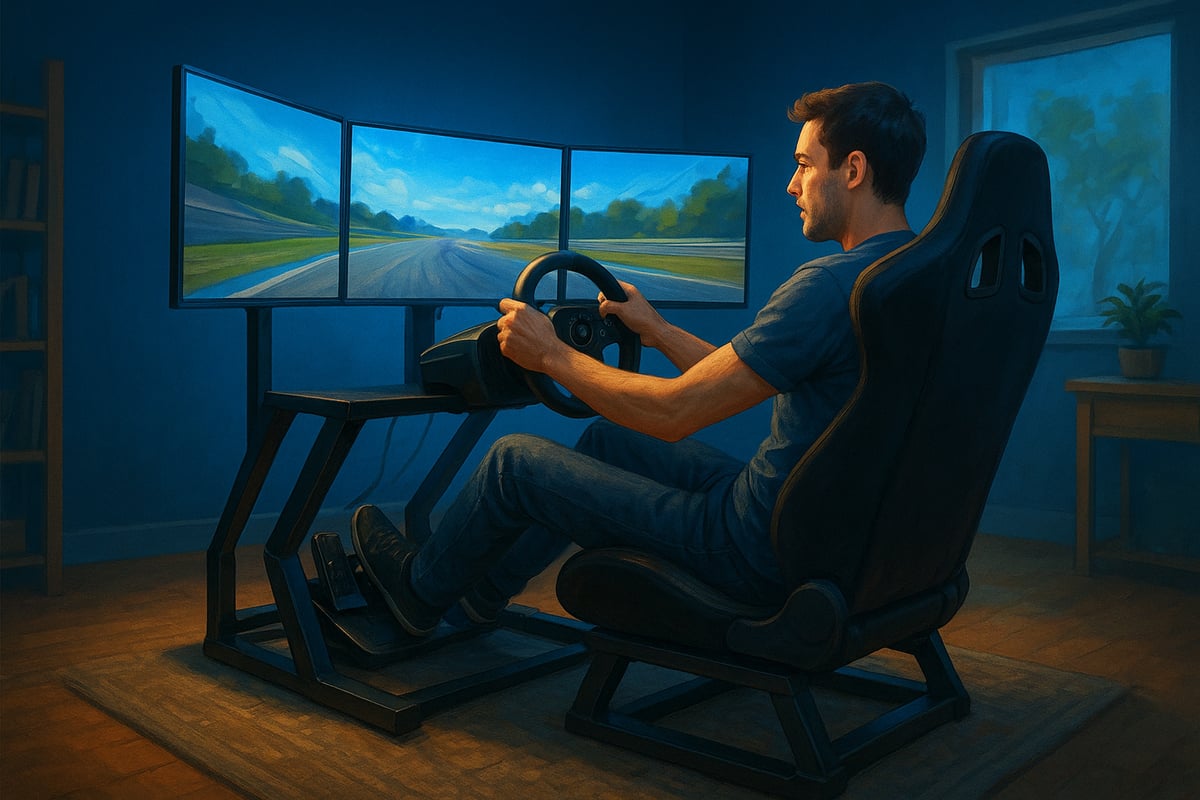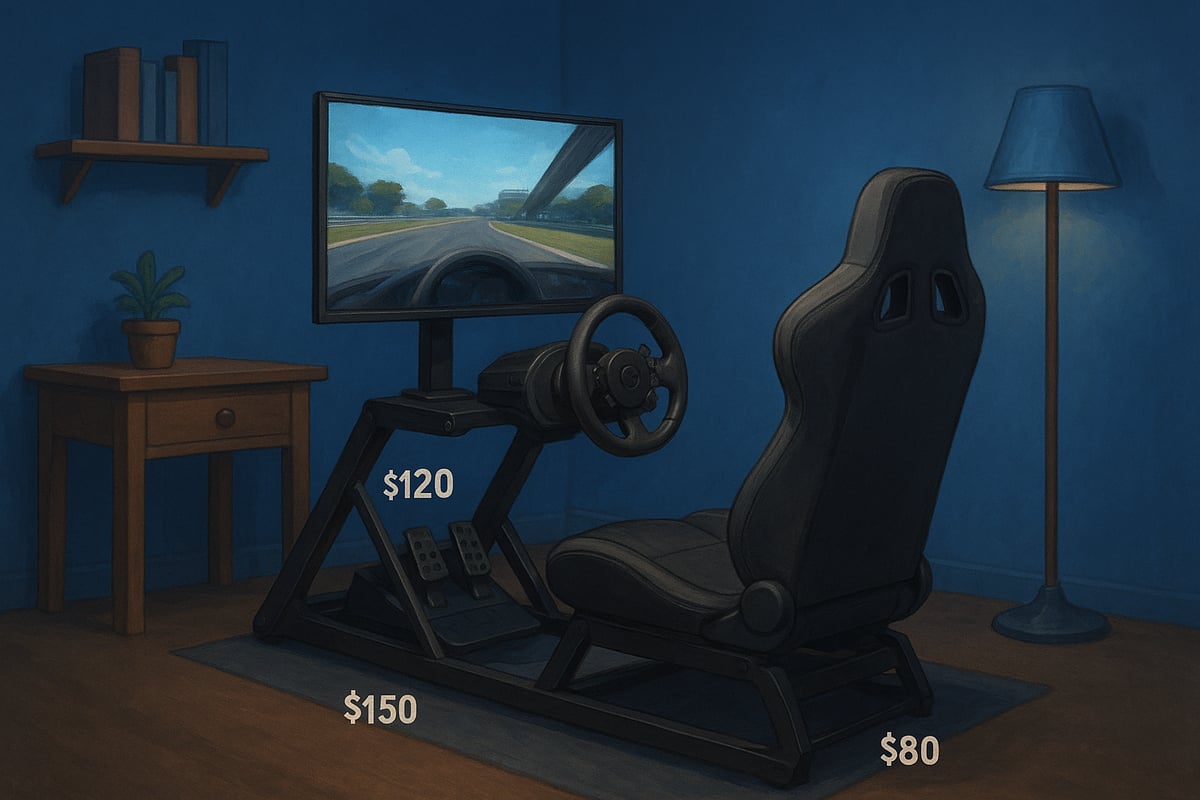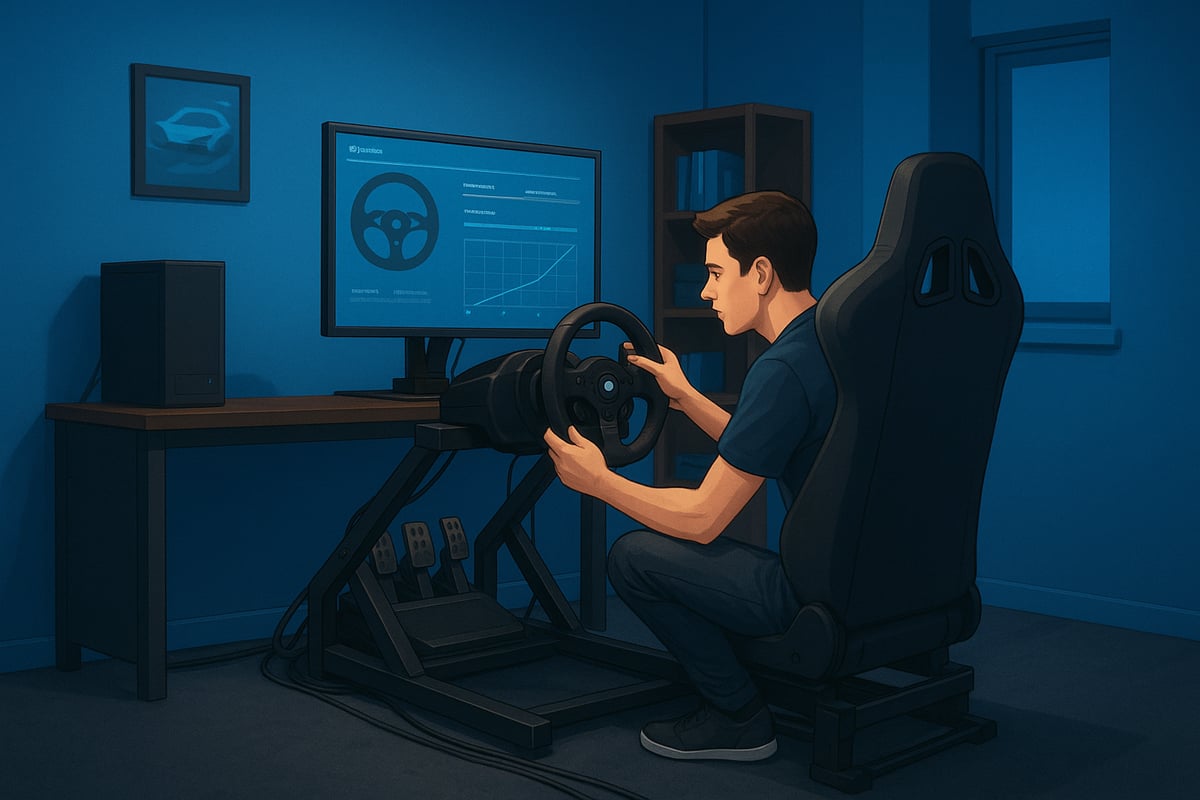
7 Essential Items For The Ultimate Budget Racing Sim Setup 2025
|
|
Ever dreamed of taking the wheel in a professional race, all from the comfort of your own home? Sim racing is booming, with more Aussies getting behind the virtual wheel than ever before.
A realistic setup can completely transform your experience, making every lap feel like the real deal. But where do you start, especially if you’re mindful of your budget?
This guide is here to help you build the ultimate budget racing sim setup for 2025. We’ll show you how to balance affordability, quality, and immersion so you get the most out of every dollar.
From racing wheels to audio and optional add-ons, we’ll cover seven key essentials that deliver serious value. Ready to level up your sim racing without breaking the bank? Read on for practical tips made just for Australian gamers.
Sim racing has exploded in popularity lately, especially here in Australia. More people than ever are looking to bring the thrill of motorsport into their homes—without breaking the bank or taking up half the living room. But why is now, in 2025, the perfect time to build your own budget racing sim setup? Let’s break it down.

Over the past few years, sim racing communities have grown rapidly, both in Australia and around the globe. Esports events are filling virtual grandstands, and local leagues are popping up in every state. Thanks to advances in technology, high quality gear is now within reach for more people, not just the pros with deep pockets.
Just look at the numbers: sim racing hardware sales grew by 30% in 2024 alone. That’s a clear sign that more Aussies are jumping into the action. It’s not just about fun, either. Affordable setups are now packed with features that used to be exclusive to high end rigs, from realistic force feedback to responsive pedals.
Cost, space and complexity have always been major hurdles. But a budget racing sim setup helps you dodge those roadblocks. Compact cockpits fit in small spaces, and plug and play gear takes the pain out of setup. If you’re curious about the community and the latest tech, check out this Growth of sim racing communities article for more insight.
Even better, newcomers are proving they can compete with veterans. Entry level racers are climbing leaderboards, showing that skill matters more than how much you spend. There’s never been a better time to start your own budget racing sim setup journey.
So, what does “ultimate” mean when we’re talking about a budget racing sim setup? It’s all about getting the maximum bang for your buck—more immersion, more performance, and more fun, for less money.
The essentials matter most: a responsive racing wheel with good force feedback, a pedal set with realistic brake feel, a comfy seat, and a crisp display. These are the components that transform your driving experience, helping you shave seconds off your lap times and feel truly connected to the car.
The secret is focusing on core gear, not flashy extras. Modular setups let you upgrade over time, so you don’t have to buy everything at once. Many popular Aussie sim racing leagues use budget setups, proving you can race competitively without going all out.
By choosing wisely, you’ll avoid overspending and get a setup that’s easy to enjoy and upgrade as your passion grows. The right budget racing sim setup in 2025 brings pro level excitement to your home—without emptying your wallet.
Ready to transform your lounge room into a virtual pit lane? Building a budget racing sim setup in 2025 is more achievable than ever, letting you chase the thrill of motorsport from home without blowing your budget. Here are the seven essential items every Aussie sim racer should consider for a setup that balances cost, quality, and pure immersion.

Your racing wheel is the heart of any budget racing sim setup. It’s the first thing you grip when the lights go out, so you want it to feel responsive and realistic. In 2025, you’ll find three main types: gear-driven, belt-driven, and direct drive. Gear-driven wheels are the most affordable, while belt-driven offers smoother feedback. Direct drive, once reserved for pros, now has entry-level options that won’t break the bank.
Wheel Type |
Feel |
Typical Price (AUD) |
|---|---|---|
Gear-driven |
Basic, notchy |
$300–$400 |
Belt-driven |
Smooth, responsive |
$400–$600 |
Direct drive |
Strong, precise |
$600–$700 |
Look for a wheel with strong force feedback, compatibility with your platform, and customisable buttons. For those intrigued by direct drive on a budget, check out this guide to the Cheapest Direct Drive Wheel Options for 2025.
A quality wheel upgrades your control, immersion, and racecraft. Beginners and intermediates will find plug-and-play options that deliver a huge leap over a standard controller. Just remember, top-tier force feedback detail is usually reserved for pricier models, but you can still get a fantastic driving feel without exceeding your budget racing sim setup allowance.
If you want to shave tenths off your lap times, your pedals matter just as much as your wheel. In a budget racing sim setup, upgrading from basic potentiometer pedals to a load cell brake can be a game-changer. Load cell technology measures pressure rather than just distance, mimicking real-world braking and letting you build muscle memory.
Key features to look for include adjustable resistance, solid build materials, and compatibility with your wheelbase. Expect to pay between $150 and $400 AUD for a quality budget pedal set. The right pedal set will help you stop on a dime, trail brake with confidence, and feel more connected to your virtual car.
Lap time comparisons consistently show drivers improve their consistency and control when switching to load cell pedals. While some budget options may lack full adjustability, the performance boost is undeniable. For anyone serious about their budget racing sim setup, prioritising a decent pedal set is a must.
A stable foundation is vital for your budget racing sim setup. Imagine nailing a perfect lap, only to have your wheel stand wobble in the heat of battle. That’s why a sturdy cockpit or stand is essential, even for budget builds. Entry-level cockpits and stands range from $200 to $600 AUD and come packed with features that suit tight Aussie homes.
Look for adjustability, foldability, and compatibility with your chosen gear. Some stands are designed to slide under the couch or fold away, making them perfect for shared spaces. A good cockpit reduces flex, improves comfort, and boosts your consistency during long sessions.
Space-saving designs are a huge win for apartment dwellers or anyone without a dedicated sim racing room. While basic models may not offer plush seating, the improved stability is a clear step up from makeshift setups. Investing in a solid cockpit or stand is a smart move if you want your budget racing sim setup to feel like the real deal.
Long sim racing sessions can be a literal pain if you’re perched on a kitchen chair. A proper racing seat transforms your budget racing sim setup, letting you focus on the drive instead of your back. Look for ergonomic design, supportive bolsters, and quality materials that hold up to hours of use.
Adjustability matters, especially if multiple people use your rig. Most budget seats ($150–$400 AUD) are compatible with popular cockpits, though you may need a separate mounting kit. The right seat reduces fatigue, supports good posture, and dials up the immersion.
You’ll find a range of styles, from bucket seats to more relaxed designs. While some budget options skimp on padding, the leap in comfort over a basic office chair is massive. For any sim racer who spends more than an hour at a time behind the wheel, a dedicated racing seat is a key part of a true budget racing sim setup.
You can have the best wheel and pedals in the world, but your visuals need to keep up. A high-refresh monitor or TV is a vital piece of your budget racing sim setup, making every apex and braking zone look and feel smoother. In 2025, you’ll find 120Hz+ monitors and TVs between $250 and $600 AUD that deliver crisp, low-lag visuals.
Key specs to watch for: high refresh rate, low response time, and a comfortable screen size for your space. Mounting flexibility is a plus, especially if you’re working with a tight area. The jump from a standard 60Hz display to a 120Hz+ screen is like trading in a family sedan for a sports car.
A better display helps with reaction time and gives you a wider field of view, making it easier to spot rivals and hit your marks. While some budget screens may need extra mounts, the upgrade is well worth it for any budget racing sim setup aiming for realism and performance.
Sound is often the unsung hero of a great budget racing sim setup. The roar of engines, the screech of tyres, and the subtle cues from your car all come alive with quality audio. Whether you prefer a headset or speakers, surround sound and comfort should be top priorities.
Budget headsets and speakers ($80–$250 AUD) now offer features like wireless connectivity, clear microphones, and immersive audio that rival pricier models. Good sound helps you judge distance, react to on-track action, and communicate in multiplayer races with ease.
Many budget options are surprisingly durable and deliver crisp, detailed audio. Cheaper models might lack a bit in build quality, but the difference in immersion is massive compared to basic TV speakers. For anyone looking to round out their budget racing sim setup, don’t overlook the power of great sound.
Want to take your budget racing sim setup up a notch? Consider adding a shifter or handbrake, especially if you’re into rally, drifting, or classic car sims. These add-ons bring a whole new layer of realism, letting you tackle tight hairpins or pull off perfect drifts.
Look for compatibility with your wheelbase, solid build quality, and mounting options that fit your cockpit or stand. Entry-level shifters and handbrakes are available from $80 to $300 AUD. They’re not essential for every genre, but for certain disciplines, they make a world of difference.
The tactile feedback of a shifter or the snap of a handbrake adds depth and excitement to your sessions. While some budget options may feel basic, the added immersion is worth considering as your budget racing sim setup evolves.
Building your budget racing sim setup is all about getting the most bang for your buck. It’s easy to get distracted by flashy add-ons, but making smart choices will help you enjoy a more immersive and competitive experience without overspending. Let’s dive into how you can stretch your dollars and make every piece of your rig count.

When you’re putting together a budget racing sim setup, prioritising is key. Focus your investment on the core trio: the racing wheel, pedal set, and a sturdy cockpit or stand. These items have the greatest impact on immersion, control, and enjoyment.
Here’s a simple priority list to follow:
Wheel & Force Feedback Base: Directly affects realism and control.
Pedal Set (with load cell brake): Key for consistent lap times.
Cockpit or Stand: Provides stability and comfort.
Many new sim racers make the mistake of blowing their budget on RGB lighting or fancy accessories before upgrading essentials. If you want the best performance boost for your money, always choose function over form. As your skills improve, you can gradually add extras like a shifter or better audio.
For a step-by-step approach to building your rig and understanding which upgrades matter most, check out the Full Racing Simulator Setup Guide. This resource breaks down each component, helping you avoid common pitfalls and maximise your budget racing sim setup.
Average Cost Breakdown Table:
Component |
Typical Budget Range (AUD) |
|---|---|
Wheel & Base |
$300–$700 |
Pedal Set |
$150–$400 |
Cockpit/Stand |
$200–$600 |
Display |
$250–$600 |
Audio (Headset/Speakers) |
$80–$250 |
Optional Add-ons |
$80–$300 |
Getting your budget racing sim setup dialled in is where the magic really happens. Even if you have the right gear, how you assemble and calibrate everything will make or break your driving experience. Want to know how to make your rig feel like a true race car cockpit? Let’s get hands-on.

First up, you’ll want to unpack each component and check all parts are included. Start with your cockpit or stand, following the instructions step by step. Many Aussies in apartment settings opt for foldable or compact cockpits, making it easy to store your budget racing sim setup when not in use. If you’re curious about which cockpits offer the best stability and space-saving features, check out the Best Racing Simulator Cockpits 2024 for some handy recommendations.
Once your cockpit is ready, mount your wheel and pedal set securely. Double-check for any wobble, as a stable base is crucial for both comfort and control. Place your monitor or TV at eye level, ideally as close to the wheel as possible to boost immersion.
Don’t forget cable management. Use Velcro straps or cable sleeves to keep wires out of the way and prevent any tripping hazards. A tidy space not only looks better but also keeps your budget racing sim setup safe and functional.
After assembly, it’s time to get your hardware and software working in harmony. Start by installing the latest drivers for your wheel and pedals. Most brands offer dedicated software, allowing you to tweak settings for force feedback, pedal sensitivity, and button mapping. Calibration is not just a one-time task—it’s the secret sauce that brings your budget racing sim setup to life.
Begin with wheel calibration. Set your rotation angle, test force feedback, and adjust dead zones. Next, calibrate your pedals, especially the brake, to ensure realistic pressure and smooth input. Many sim racers notice an instant improvement in lap times after proper calibration.
If you’re running a shifter or handbrake, assign the correct inputs and verify responsiveness. Don’t be afraid to experiment with force feedback and pedal curves until it feels right for your driving style.
A well-calibrated setup translates to more consistent lap times and a better feel on track. Take a before-and-after test lap—you’ll be surprised how much more immersive and responsive your budget racing sim setup feels with everything dialled in.